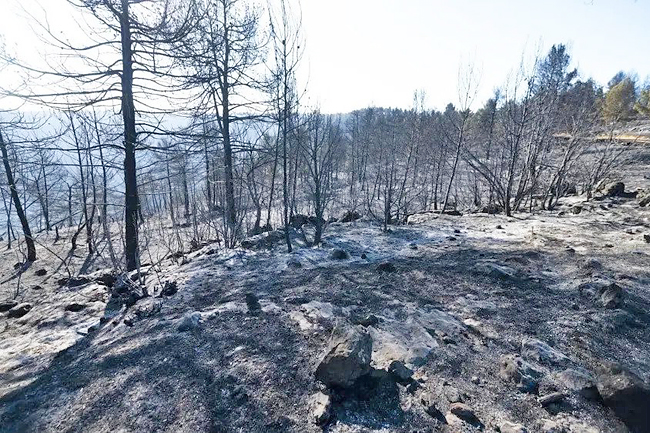TÁBARA, SPAIN, (AFP) – Walking through the charred remains of the forested hillsides of Sierra de la Culebra that were devastated by Spain’s worst wildfire last year, Pablo Martin Pinto is blunt.
“We are moving from the era of big forest fires to mega forest fires in Spain,” said this wildfire expert from Valladolid University, warning that such vast blazes were “here to stay”.
Last year, Spain suffered nearly 500 wildfires that devastated huge swathes of land, with experts warning that such California-style blazes were likely to increase.
Although spring has only just begun, some 700 firefighters have been battling Spain’s first major forest fire which has so far burnt through some 4,000 hectares of land, forcing 1,500 people to flee. Firefighters said such a blaze was more typical of summer than spring.
“We have to learn as much as we can from what has happened,” said Martin Pinto.
If Spain experiences “another summer in which temperatures don’t fall below 35 degrees Celsius for 20 days and it doesn’t rain for four months, the vegetation will be liable to go up in flames” with the first lightning bolt, he warned.

Located in the northwestern region of Castilla y Leon, Sierra de la Culebra was ravaged by fires in June and July, with more than 65,000 hectares burnt – a fifth of the total area affected in Spain last year.
The blaze also claimed four lives. During the blaze, tractor driver Angel Martin from the nearby town of Tabara won hero status after footage emerged of him working to clear a strip of land to create a fire break.
He managed to escape but suffered extensive burns, which claimed his life three months later.
The fire damage has meant the town will lose its annual income of EUR80,000 from selling firewood, said mayor Antonio Juarez.
The fire also destroyed an area popular for hunting and mushroom gathering, and ravaged an area widely enjoyed by locals.
The forest might one day live again, but “no-one who is alive today will be around to see it”, said Juarez.
According to the United Nations (UN), more than 1.6 billion people depend on forests worldwide, with the 2015 Paris Agreement establishing a framework to halt and reverse deforestation which is advancing at a rate of 10 million hectares per year. Experts said conserving Spain’s forests is key to addressing the risk of wildfires. The forests “must be protected” by looking after the undergrowth that can generate wildfires, which will also help protect “a resource which generates economic activity”, said forestry policies director in the Castilla Leon region, Jose Angel Arranz Sanz.
And Martin Pinto advocates the creation of areas which are “more resilient” featuring a varied “patchwork landscape” made up of “wooded forest areas.. and livestock farms, interspersed with areas of scrubland”.
Where forested landscapes are more homogenous, “it really limits the ability to stop a fire from spreading”, he warned.




